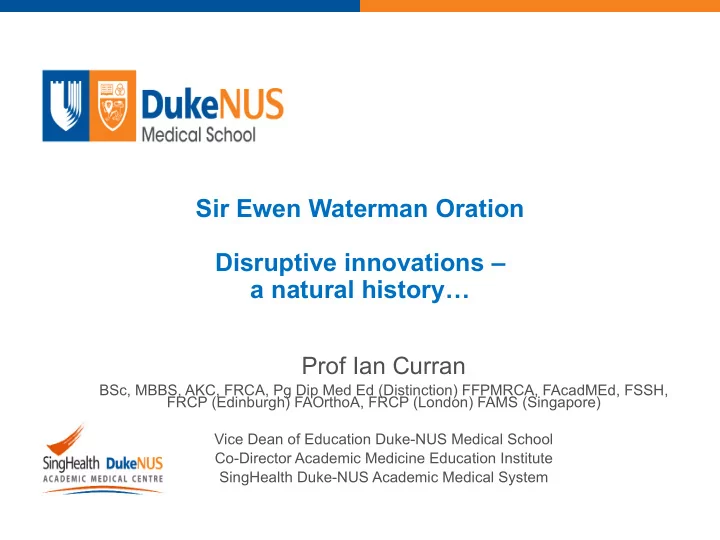

Sir Ewen Waterman Oration Disruptive innovations – a natural history… Prof Ian Curran BSc, MBBS, AKC, FRCA, Pg Dip Med Ed (Distinction) FFPMRCA, FAcadMEd, FSSH, FRCP (Edinburgh) FAOrthoA, FRCP (London) FAMS (Singapore) Vice Dean of Education Duke-NUS Medical School Co-Director Academic Medicine Education Institute SingHealth Duke-NUS Academic Medical System
Overview Consider the natural history of disruptive innovations Explore why ‘good businesses fail’… Consider the implications for Higher Education and Healthcare. Introduce concepts and approaches that might provide insights, opportunities or solutions
Along the way… …introduce…
…redeem…
…caution…
What is an innovation…?
… a transformational idea…
… a useful idea…
…with actual value…
…affordance, context and utility…
…innovators…
…address unmet demand, need and want… …developing and successfully implementing new solutions and ideas New market creating innovations
…other examples…
Incremental Improvements…
…and disruptive innovations…
…continuing disruptive innovations…
…introduce…
Theory of disruptive innovation, wealth and market creation
Everybody is a critic…
…redeem…
The transformational leader’s dilemma… “ There is nothing more difficult to take in hand, more perilous to conduct, or more uncertain in its success, than to take the lead in the introduction of a new order of things. For the reformer has enemies in all those who profit by the old order, and only lukewarm defenders in all those who would profit by the new order . ” Niccolo Machiavelli, 1469- 1527
Gartner Hype Curve ‘Curran curve of ultimate redundancy’
Types of innovation…
Old innovations…
New innovations
3 Ways of generating value or wealth Make or produce things Solve things ‘Focused Factory’ ‘Solution Shop’ Enable or share things ‘Value-adding network’
Types of innovations Sustaining or incremental process innovations - quality improvement Technological innovations – new capacity or capabilities Business model innovations – new funding/finance models Frugal innovations – more cost-effective, limited scope Regulatory or standards reform – ‘Goldilocks’s bureaucracy’ Behavioural innovations – personal/collective changes in behaviour Transformational vs transactional – cultural/leadership changes
Sustaining or Incremental innovations
Technological innovations Performance Time
Business model innovations
Frugal innovations…
Avoid over-engineering solutions…
Behavioural innovations
Optimism/pessimism
Natural history of innovations… New market creating innovations
Natural History of innovations Initial centralisation Discovery Simplification Standardisation Efficiency Commoditisation Later decentralisation Widening access Future disruption Enduring uncertainty and conceptual instability
What makes a transformational leader?
An ability to adapt and cultivate change… Openness and curiosity Associational thinking Subject matter expertise Pattern recognition Intrinsic motivation Courage to innovate Pursuit of excellence
Innovators - skills and capabilities Challenging the status quo Observing – Questioning – Thinking – Networking – Disruptive – Taking and managing risks Behavioural Skills Communication – Collaborative – Entrepreneurial –
A chilly lesson from history…??
Kelvinator, Frigidaire, Electrolux…
…the moral of this chilly tale?
Never mistake the ACTIVITY…
…for the VALUE proposition
So how might we apply this insight to healthcare?
…and Higher Education… Never value teaching over learning! …or education over the capability so created
Patients value… …kind, capable, compassionate clinicians
Employers value … … clinicians who work safely and effectively in teams …lead and improve clinical services
Professionals value… …being valued… …being given the support, time and resources to do the many facets to their jobs as well as they possibly can…
Public value…?
Governments value… …safe, accountable, cost effective healthcare
What should we ‘Value’… Public Patients ‘Value Governments Paradox’ Employers Clinicians
Beware iceman thinking…
So beware cognitive biases…
Data and judgement… W Edward Deming "In God we trust, all others bring data.
Beware incomplete understanding and over-simplification of complex systems…
Meaningful Metrics – The wisdom of McNamara’s Fallacy The first step is to measure whatever can be easily measured. This is OK as far as it goes.
McNamara’s Fallacy The second step is to disregard that which can't be easily measured or to give it an arbitrary quantitative value. This is artificial and misleading.
McNamara’s Fallacy The third step is to presume that what can't be measured easily really isn't important. This is blindness.
McNamara’s Fallacy The fourth step is to say that what can't be easily measured really doesn't exist. This is suicide.
‘…We start out with aim of making the important measurable but usually only make the measurable important… ‘
On data and measurement … ‘If you torture the data long enough , it will confess to anything’ Ronald Coase 1910-2013
Current healthcare challenges… Performance Safety Quality Resources Productivity Culture Leadership
Current Higher Education challenges… Performance Safety Quality Resources Productivity Culture Leadership
Healthcare challenges • Complexity healthcare system • Lack of system integration/coherence • Capacity and capability • Individualised needs and wants of patients • Workforce issues • Complexity of disease and healthcare treatments
‘Grey tsunami’
Challenges in Numbers - service 1 in 3 150 12,458… 67,000… ICD11…
Importance of leadership… Performance Behaviour Language Culture Trust
Transactional leadership…? …process-orientated leadership
Nature and Language of Transactional Leadership… • Hierarchy • KPIs • Command control • PIDs • Edict/order • Milestones • Explicit goals • Outputs • Targets • Contracts • Products • Performance Mx • Delivery • Quality improvement • Closed loop • Compliance… • Rational • Evidence/data • Metrics • Process • Tariff
Transactional leadership… • Pros… • Cons…
‘Transactional’ Approaches to problem solving A finite game… Closed loop Closed economy Success/fail Win/lose Penalty/reward
Frescoball • Infinite game • Enduring • No winners/losers • No definite endpoint
…transformational leaders…
Recommend
More recommend